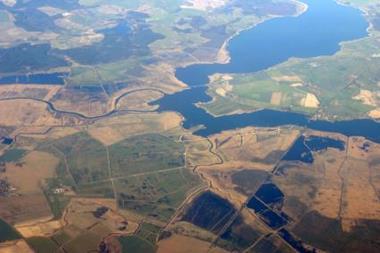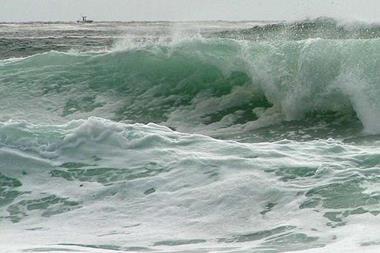Summer floods in England highlighted how even moderately sized events can cause widespread damage and disruption, but a similar size flood in London would have been far more costly. By Jane Toothil
The UK floods in June and July 2007 were devastating to the local areas, but the likely insured losses, currently estimated at between £2.25 billion and £3.25 billion, are significantly smaller than if a similar size flood had inundated central London. Is such widespread flooding in the capital really possible and what are the potential consequences?
Thanks to the protection offered by the Thames Flood Barrier, it is easy to become complacent about the level of hazard faced by the capital. No serious river flood has hit central London recently but, in fact, there is a history of flooding along the lower Thames, with significant flooding occurring in central London in 1236 and 1663, and more recently, in 1928,
when 14 people drowned. In 1953, there was disastrous flooding along the east coast of England, including the Thames estuary, but on this occasion, London itself was spared. Had the devastation seen in other areas of England, which included the destruction of 24,000 houses, reached the capital, the social and economic impact of this event would have been even more severe.
London is, unfortunately, well placed to be at risk from several sources of flooding:
• Pluvial flood: due to run-off following short, intense rainfall directly over the affected area
• Fluvial flood: overflowing of rivers following longer periods of precipitation in upstream catchment areas
• Sea surge: due to increased sea levels following windstorm
London is protected from all three types of flooding by defences systems, but there remains a risk of failure, and human error can also have an impact on the consequences of natural events.
Unpredictable or catastrophic
Pluvial flood differs from fluvial and sea surge in that it can occur in almost any part of the city following intense precipitation, as we saw on 20 July 2007 in southwest London, rather than in predictable areas adjacent to streams and rivers. The main defence against flood from water
run-off after heavy rain is the sewer and drainage system below London’s streets, much of which was constructed many decades ago. The size and even location of drainage systems in older parts of the city are not well recorded, and the level of protection offered is generally considered to be in the order of 1 in 10 years.
Pluvial flood, therefore, has a high probability of occurence in London, and the difficulty of defending against it potentially exacerbates its impact. Also, given the unpredictable nature of such flooding, good underwriting practice cannot easily mitigate the risk in the same way that is possible for fluvial or sea surge flooding. Fortunately, pluvial flood does not cause devastation over such a large area as other types of flood.
It is sea surge which has the potential to cause the most catastrophic losses in central London. Sea surge is defined as the excess height of the observed tide above the predicted level, which, if large enough, can lead to serious coastal flooding. It can follow the development of extra-tropical cyclones. Two main factors contribute to the generation of a large surge event: low pressure at the centre of a storm that causes the sea level to rise and, more significantly, high winds
associated with a large and persistent pressure
gradient that can push water towards the shore.
The destructive force of a surge event depends not only on the strength of the low pressure system, but also on where the event falls in relation to the tidal cycle. The most destructive surge events occur when large, wind driven surges coincide with high tides. The vulnerability of a particular location to a surge event will be influenced by the shape, bathymetry and topography of the coast, in addition to the performance of existing, man-made sea defences.
The 1953 event , which caused many sea defences systems to fail and resulted in over 2,000 deaths in the United Kingdom and the Netherlands, demonstrated well the potential for catastrophic loss from sea surge. .
Risk Management Solutions (RMS) has estimated that a repeat event today in terms of area flooded would result in a loss of £5.5 billion, with associated business interruption adding significantly to this figure. If an event of this nature were also to inundate central London, the losses would be much higher. Figures from the Association of British Insurers (ABI) show that £125 billion of assets lie within the tidal floodplain of London. The Greater London Authority (GLA) has also published estimates to suggest that losses resulting from a serious flood in central London could reach £20 billion, with the Thames Gateway area adding a further £7 billion.
Defences
London’s current defence system against sea surge has one especially critical component in the Thames Flood Barrier. Built between 1974 and 1982, the barrier was used for the first time in 1983 and since then has been used over 100 times. The barriers current design standard of 1 failure in 10,000 closures is in excess of the original design standard of 1 failure in 1,000 closures.
The threat from sea surge, however, is expected to increase due to a combination of factors, including climate change and the sinking of southeast England due to glacial rebound. As the frequency of events increases, the reliability of the Thames barrier, assessed on an annual basis, decreases. With tide levels rising at an estimated 60cm relative to the land each century, the level of protection offered by the barrier needs to continue to increase.
Currently, however, the Thames Barrier is generally considered to be adequate to protect London, so the probability of serious sea surge flooding in London is extremely small, as it would require not only a serious sea surge, but also barrier failure.
If this happened, however, the story would be different. Recent work carried out by Guy Carpenter shows that under a sea surge and barrier failure scenario, flooding would occur in central London for events with a return period as small as 1 in 10 years. For a 1 in 250 year sea surge event, the results are potentially serious and extensive, as illustrated in Figure 1, on the previous page. It shows in blue the potentially inundated area in the Thames and its tributaries due to a 1 in 250 year water level from sea surge, combined with average tide and assuming defence failure. The potential river flood extent for the same return period, also assuming defence failure is shown in magenta.
This modelling work has been carried at a highly detailed level based on a 1m light detection and ranging (LiDAR) digital terrain model provided by InfoTerra, and water propagation modelling using JFlow-GPU, the proprietary flood propagation modelling software of JBA Consulting. Modelling of defence failure is carried out using information from the Environment Agency’s national flood and coastal defence database.
For potential flood defence breach sites along the river system, the expected resultant extent of inundation per individual defence failure is determined. The sum of these flood extents provides the 1 in 250 year “floodplain boundary”, which defines the area in which any individual point is exposed to flooding from a 1 in 250 year water level, given defence and barrier failure. Along the Thames itself, it is the sea surge water level which is higher for a 1 in 250 year return period; hence the floodplain boundary is governed by the sea surge rather than
fluvial flood.
Although it is highly improbable, even after barrier failure, that all defences along the Thames would fail, these results nonetheless show the extent of potential exposure to flood in London were the defence system against sea surge to fail. Considering sea surge specifically, some 180,000 residential properties and 30,000 commercial properties lie within the floodable area. Given ABI estimates of losses to property from the UK summer 2007 floods of an average of £35,000 for homeowners and £90,000 for businesses, the potential damage figures for property alone could quickly reach several billions of pounds.
In fact, direct property damage may not be the largest portion of claims following a large scale flood event. Business interruption costs following flooding are extremely difficult to estimate, but can be very significant, especially in a city such as London which relies heavily on its ability to transport workers to the city centre every day. Pluvial flooding in Camden on 7 August 2002 resulted in damage of over £1 million, with the associated traffic disruption estimated to cost at least £100,000 per hour delay on each main road affected.
City wide disruption could be extremely severe, especially if gas, electricity and telecommunication systems were also severely affected. The ability to restore basic facilities to an inundated area following an event depends on working transport systems, and the largest events may simply outstrip the capacity of labour available to carry out the repairs.
British Power International warned in early May 2002 that several companies use the same pool of contractors to provide mobile generators, engineers for overhead lines and the technology to handle surges in calls, and that they would have to compete for these services in a widespread emergency. When the costs of contingent business interruption are added to the equation, there can be no doubt that a large scale flood event in central London could have extremely severe consequences, not only for the insurance industry and directly affected business, but also for the UK economy as a whole.
Postscript
Jane Toothill is head of model development,
Guy Carpenter Instrat, Europe.
Email: jane.toothill@guycarp.com
Website: www.guycarp.com



















